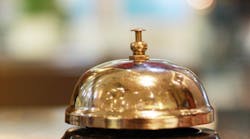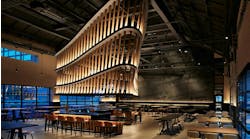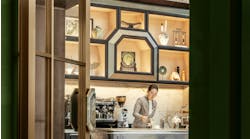The hospitality industry is evolving at a staggering rate with technology and expectations constantly changing. Lesley Hughes Wyman and Tamara Ainsworth, principal interior designers for MatchLine Design Group, address some of the most common questions they face when keeping hotel design current.
1. What elements are the most requested by hoteliers in designing for their brand/franchise?
Most clients want to create a “wow” moment within the property and all request to localize the feel of the hotel, whether it’s through materials, artwork, or the overall theme. Wellness is a hot topic, and is being incorporated with food and beverage components, recreational offerings and experiences, and in-room amenities; the destination bar is still a high priority and revenue driver for owners.
2. How do you guide hoteliers in making the best hotel design choices?
Hoteliers look to us to guide them toward products that appear premium and durable, as well as budget friendly. It’s often difficult to achieve all three, but we enjoy the challenge to deliver a terrific final design. We are transparent with our clients and make sure to give them all the facts about the selections and spell out what they are paying for, and what the benefits and/or trade-offs may be.
3. How do trends fit into this puzzle? Are they left by the wayside, integrated subtly, or dominate a design?
We like to design with an eclectic style in mind – many elements are modernized versions of classic stylings, but we always like to add in a few unique pieces. It’s important not to rely heavily on trends. Trends are temporary and fall in/out of favor quickly so it’s not really a wise investment. To save our clients grief, we typically limit trendier pieces to small items that the client can replace without sending them broke! For example, we’d suggest an accent wall, paint, a single unique chair, accessories, and a few revolving art pieces, all of which can transform a space easily. We tend to keep architectural elements in line with classic vernacular, since these tend to be more cost intensive.
4. What hotel design elements are brands leaving behind? How has the changing marketplace impacted this move?
Anything that’s closed off or does not promote social engagement or connectivity is really out the door. With social components becoming increasingly important, public areas are being transformed into hybrid spaces. For instance, lobby spaces are now also co-working spaces and reception desks can double up as a bar area. Connectivity is key to an effective design concept.
5. How are brands making their new locations standout? What approach seems to be most popular and most successful?
It’s still a team effort even after the project is completed and open – great design and great service really go hand-in-hand. We can design an awesome lobby lounge, but if the food or service is lacking in quality, guests will not return (and vice versa). Integrating the local story throughout the design always works well. The key is to be subtle enough to avoid kitschy-ness, but then not so far out of left-field that no one can really tell what the story is.
6. How are these brands using dedicated food and beverage spaces to cater to both hotel guests and locals?
Playing upon the local cuisine through a hotel’s food and beverage outlets reinforces the sense of place for both visitors and hometown guests. Locally sourced ingredients for the food offerings is paramount and infers freshness and quality. We have had properties showcase local vineyards, breweries and distilleries for the cocktail offerings, as well as local-favorite small-batch coffee and pastries.
7. What hotel design elements are the most timeless in the hospitality realm? Are there any you recommend to clients?
For big-ticket items such as ceiling elements, the larger lighting pieces and casegoods, we try to impart a more timeless design, assuming they will be staying through the next renovation. We will also design guest room casegoods with certain elements—hardware or an accent panel, for example—that could easily be changed out to update the look while keeping the frame intact.
Brand Renovations: A Tree Grows in Manhattan
8. What designs are most effective in today’s marketplace? Are there particular layouts you implement?
Open floor plans/designs continue to work most effectively in today’s marketplace to engage the guest and encourage social interaction. A variety of seating opportunities, including quiet, out-of-the-way areas, community tables for those who wish to work but still engage, and larger interactive seating areas for groups who wish to mingle.
9. How are hoteliers integrating sustainable elements?
Please provide a couple of examples. One example of small-scale and budget friendly and one example of large-scale with generous budget.
Some owners want to have a LEED project or other similar certification, but many simply cannot afford the time or budget. We have just completed an Embassy Suites in Denton, Texas that’s in the middle of the certification process as we speak - the project was designed to achieve Gold LEED certified.We used recycled materials such as glass countertops, table tops made of recycled chipboard, reclaimed wood wall accents, and collaborated with local artisans for custom glass divider walls and artwork. Green walls and water walls also contributed to the sustainable elements, and there are solar panels and other energy efficient architectural elements throughout the property.
Workplace Design: Along the L.A. Skyline
For these type of projects we simplify our approach— we source materials locally and immerse ourselves in the food scene to understand the flavors of the neighborhood to deliver a unique experience. In the case of our Embassy Suites in San Antonio, they have chef-driven on-site garden and honey bees. All of these elements are present in their menus and incorporated within their products, adding to the narrative of the property.
10. How can hoteliers create “social media moments” without jeopardizing the hotel design concept?
The key to creating these specific moments is blending them together seamlessly with the rest of the design. We don’t want to sacrifice important elements of the overall design. For example, we avoid carving out a section of a lobby for guests to take a photo and leave. That does nothing for the design of a property. Guests want to explore, discover and experience cool spaces on their own – that’s part of the fun of travel.
11. Are hoteliers requesting more “flex-space” to make the most of real estate? For example for lobbies to have the capabilities to function as co-working spaces?
Clients and hotel brands most certainly are! Public space needs to attempt to be everything for everyone. Business travelers and vacationers, and then leading to the “Bleisure Traveler”. Lobbies and food and beverage outlets are becoming one in the same in a lot of properties – acting as meeting spots, remote working while traveling, grabbing coffee or drinks, and then having a meal.
12. Do millennials still play a role in shaping hotel design? What other generational demographics are important to take note of?
They still do to some degree, but really, every generation wants the same thing: seamless design, impeccable service, easy and convenient connectivity and a great night’s sleep. We think it’s important not to gloss over the other generations regarding design. There may be a higher quantity of one group, but then there’s another group willing to pay more for certain elements, and then another group that finds loyalty to a brand of greater importance. It takes all kinds!
More Reading Just For You: Encouraging Self-Expression through Design


